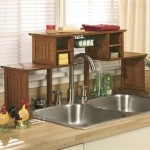Farm Sink With Butcher Block Countertop: A Practical and Stylish Kitchen Combination
The combination of a farm sink and a butcher block countertop represents a popular design choice for kitchens seeking a blend of functionality, durability, and aesthetic appeal. This pairing evokes a sense of rustic charm while offering practical benefits for modern culinary activities. Understanding the characteristics of each element – the farm sink and the butcher block – is crucial for making an informed decision about incorporating this combination into a kitchen space.
A farm sink, also known as an apron-front sink, is defined by its exposed front that extends beyond the cabinet face. This design element differentiates it from traditional drop-in or undermount sinks. Farm sinks are typically large and deep, offering ample space for washing bulky pots, pans, and even large produce items. They are available in a variety of materials, including fireclay, stainless steel, cast iron, and composite materials. The choice of material impacts the sink's durability, maintenance requirements, and overall aesthetic.
Butcher block countertops are constructed from multiple pieces of wood glued together to form a solid surface. The wood can be arranged in various patterns, such as edge grain, end grain, or face grain, each offering a distinct visual appearance and level of durability. Common wood species used for butcher block include maple, walnut, cherry, and oak. The inherent qualities of wood, such as its warm tone and natural grain, contribute to the countertop's aesthetic appeal. Furthermore, butcher block provides a resilient surface that can withstand heavy use and can be refinished over time to restore its appearance.
Key Considerations When Choosing a Farm Sink
Selecting the appropriate farm sink involves careful consideration of several factors. The material, size, and installation method are all critical aspects that influence the sink's performance and integration into the kitchen design.
Material: Fireclay is a popular choice for farm sinks due to its durability and resistance to stains and scratches. However, it can be prone to chipping if subjected to significant impact. Stainless steel offers a modern aesthetic and is resistant to rust and corrosion, but it can be susceptible to scratching and denting. Cast iron sinks, coated with enamel, provide a classic look and are durable, but the enamel coating can chip over time. Composite materials offer a balance of durability and affordability, often mimicking the appearance of more expensive materials.
Size: The size of the farm sink should be proportionate to the size of the kitchen and the available cabinet space. A larger sink offers greater utility for washing large items, but it can also dominate a smaller kitchen. Careful measurement of the cabinet space is crucial to ensure that the chosen sink fits properly. Consider the internal dimensions of the sink bowl and the external dimensions, including the apron front, to avoid installation issues.
Installation: Farm sinks typically require specialized cabinet modifications to accommodate their apron front. The cabinet must be cut to allow the sink to sit flush with the countertop. This often necessitates custom cabinetry or modifications to existing cabinets. Professional installation is recommended to ensure proper support and alignment of the sink, preventing leaks and ensuring structural integrity. Undermount installation is the most common method for farm sinks, creating a seamless transition between the sink and the countertop.
Key Considerations When Choosing a Butcher Block Countertop
Selecting the right butcher block countertop involves evaluating factors such as wood species, grain orientation, and sealing methods. These elements contribute to the countertop's durability, maintenance requirements, and overall aesthetic.
Wood Species: Maple is a popular choice for butcher block countertops due to its hardness, durability, and neutral color. Walnut offers a richer, darker tone and is also durable, but it can be more expensive than maple. Cherry provides a warm, reddish hue and is relatively soft, requiring more careful maintenance. Oak is a strong and durable wood with a distinctive grain pattern, but it can be prone to staining if not properly sealed. The choice of wood species should be based on aesthetic preferences, budget considerations, and the anticipated level of use.
Grain Orientation: Edge grain butcher block features wood pieces arranged with their edges facing up, providing a durable and stable surface. End grain butcher block features wood pieces arranged with their ends facing up, offering the most durable surface and self-healing properties for knife marks. However, end grain butcher block is typically more expensive. Face grain butcher block features wood pieces arranged with their faces facing up, providing a visually appealing surface but offering the least durability. The grain orientation should be selected based on the intended use of the countertop and the desired level of durability.
Sealing: Butcher block countertops require regular sealing to protect them from moisture, stains, and bacteria. Food-safe mineral oil is a common sealant that penetrates the wood and creates a barrier against moisture. Wax finishes can also be used to provide additional protection and enhance the wood's natural luster. Regular application of sealant is crucial to maintain the countertop's appearance and prevent damage. Avoid using harsh chemicals or abrasive cleaners on butcher block countertops, as these can damage the wood and compromise the sealant.
Integrating the Farm Sink and Butcher Block Countertop
Successfully integrating a farm sink and butcher block countertop requires careful planning and execution. The sink and countertop must be compatible in terms of size, style, and functionality. Proper installation and maintenance are essential to ensure the longevity and performance of both elements.
Aesthetic Harmony: The style of the farm sink should complement the aesthetic of the butcher block countertop. A stainless steel farm sink pairs well with a lighter-toned maple butcher block, creating a modern and clean look. A fireclay farm sink with a classic design complements a darker walnut butcher block, evoking a more rustic or farmhouse aesthetic. The color and texture of the sink and countertop should be considered to create a cohesive and visually appealing design.
Functional Considerations: The depth of the farm sink should be appropriate for the intended tasks. A deeper sink is suitable for washing large pots and pans, while a shallower sink may be sufficient for everyday tasks. The overhang of the butcher block countertop should be considered to provide adequate workspace around the sink. A slight overhang prevents water from dripping onto the cabinets and provides a comfortable area for food preparation.
Maintenance Synergy: Both farm sinks and butcher block countertops require regular maintenance to maintain their appearance and functionality. Proper cleaning and sealing are essential to prevent stains, scratches, and bacteria growth. The maintenance routines for the sink and countertop should be compatible to ensure that both elements remain in optimal condition. Using appropriate cleaning products and following recommended maintenance schedules will prolong the lifespan of both the farm sink and the butcher block countertop.
The combination of a farm sink and a butcher block countertop offers a practical and aesthetically pleasing solution for kitchen design. The large and deep farm sink provides ample space for washing and cleaning, while the butcher block countertop offers a durable and warm surface for food preparation. By carefully considering the material, size, installation, and maintenance requirements of both elements, homeowners can create a kitchen space that is both functional and beautiful.

Diy Install An Apron Front Sink With A Butcher Block Countertop I Spy

Best Kitchen Sink Styles For Butcher Block Countertops Hardwood Reflections

Diy Install An Apron Front Sink With A Butcher Block Countertop I Spy

Installing Butcher Block Counter Tops Doors And A Farmhouse Sink Orc Week 5 Kitchen Update This Mamas

Diy Install An Apron Front Sink With A Butcher Block Countertop I Spy

Best Kitchen Sink Styles For Butcher Block Countertops Hardwood Reflections

A Black Farmhouse Sink Gives Our Country Kitchen Warm Feel

Farmhouse Sink With Maple Butcher Block Countertop Cottage Kitchen

Diy Install An Apron Front Sink With A Butcher Block Countertop I Spy

Pin Page







